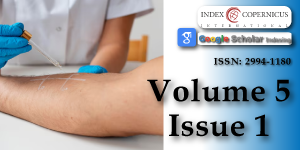Drug Eruptions at Patients in Consultation at the Dermatology Department of the Dermatology Teaching Hospital in Bamako, Mali: Epidemiological, Clinical and Etiological Study
Main Article Content
Article Details
Copyright (c) 2021 Karabinta Y, et al.

This work is licensed under a Creative Commons Attribution 4.0 International License.
Privat Y. Toxidermies médicamenteuses, diagnostic et prévention. Ann Dermatol Venereol. 2003; 130: 159-153.
Roujeau JC, Wolkenstein P. Réactions cutanées aux médicaments. In Dermatologie et infections sexuellement transmissibles ; 4èmeé dition Masson. Paris. 2000; 385-392.
Ramorasata JA, Raveloson NE, Tohaina D, et al. Caractéristiques épidémio-cliniques des nécrolyses épidermiques toxiques dans le service de réanimation de l’Hôpital de Soavinandriana Antananarivo. Rev Anest Réa Urg. 2009; 1: 21-25.
Atadokpede F, Yedomon H, Adegbidi H, Sehonou JJ, Azondekon A, et al. Mucocutaneous manifestations of human immunodeficiency virus infection in Cotonou, Benin. Med trop. 2008; 68: 273-276. PubMed: https://pubmed.ncbi.nlm.nih.gov/18689320/
Begaud B, Evreux JC, Jouglard J, G Lagier. Imputation of the unexpected or toxic effects of drugs. Actualization of the method used in France. Therapie. 1985; 40: 111-118. PubMed: https://pubmed.ncbi.nlm.nih.gov/4002188/
Safiatou I. Réactions cutanéo-muquqeuses d’origine médicamenteuse, thèse de médicine Fmpos n°07M197.
Özkaya E. Specific site involvement in fixed drug eruption. J Am Acad. Dermatol. 2003; 49: 1003-1007. PubMed: https://pubmed.ncbi.nlm.nih.gov/14639376/
Harugeri BM, Sanmukhani J, Patel T, Paliwal N, Shah H, Tripathi C, et al. Drug induced Stevens - Johnson syndrome, toxic epidermal necrolysis, and SJS-TEN overlap: A multicentric retrospective study. J Postgrad Med. 2011; 57: 115-119. PubMed: https://pubmed.ncbi.nlm.nih.gov/21654132/
Weeranut C, Leena C, Kanokvalai K, Jongjarearnprasert K, Dhana N. Cutaneous adverse reactions to sulfonamide antibiotics. Asian Pac J Allergy Immunol. 2011; 29: 284-289. PubMed: https://pubmed.ncbi.nlm.nih.gov/22053600/
Krebs A, Boillat-Armagni C, Saurat JH. Réactions cutanées aux médicaments. In: Dermatoses des états d'hypersensibilité 2ème ed. Paris: Masson. 1990: 911.
Ramorasata JA, Raveloson NE, Tohaina D. Caractéristiques épidémio-cliniques des nécrolyses épidermiques toxiques dans le service de réanimation de l’Hôpital de Soavinandriana Antananarivo. Rev Anest Réa Urg. 2009; 1: 21-25.
Khaled A, Kharfi M, Ben Hamida M, El Fekih N, El Aidli S, et al. Cutaneous adverse drug reactions in children. A series of 90 cases. Tunis Med. 2012; 90: 45-50. PubMed: https://pubmed.ncbi.nlm.nih.gov/22311448/
Aguèmon AR, Houngbé F, Yaméogo TM. Nécrolyse épidermique toxique, revue des cas Observés dans le service de réanimation du centre national hospitalier et universitaire de Cotonou. Ann Fr Anesth Réanim. 2006; 25: 505-509.
Bahadoran P, Castanet J, Lacour LP, Perrin C, Del Giudice P, et al. Pseudo-dermatomyositis induced by long-term hydroxyurea therapy: report of two cases. Br J Dermatol. 1996; 134: 1161-1163. PubMed: https://pubmed.ncbi.nlm.nih.gov/8763456/

